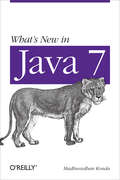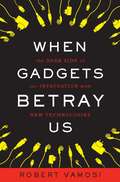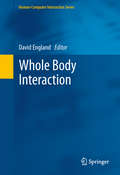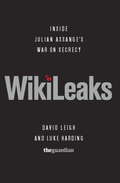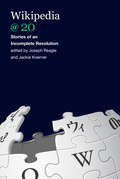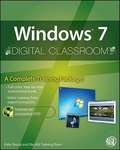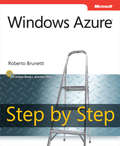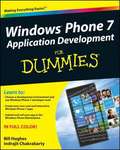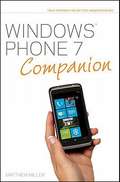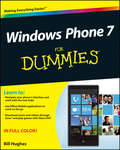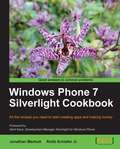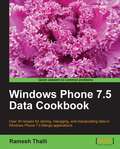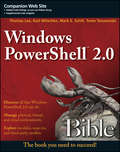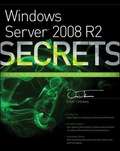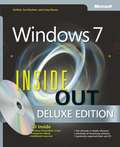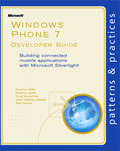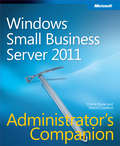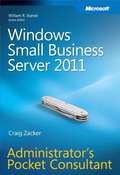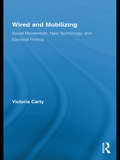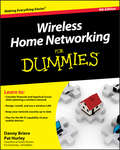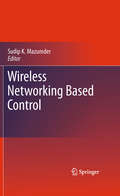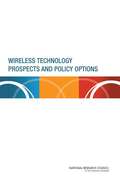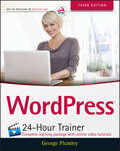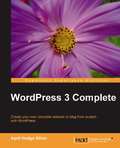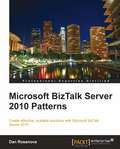- Table View
- List View
What's New in Java 7
by Madhusudhan KondaJava 7 has a number of features that will please developers. Madhusudhan Konda provides an overview of these, including strings in switch statements, multi-catch exception handling, try-with-resource statements, the new File System API, extensions of the JVM, support for dynamically-typed languages, and the fork and join framework for task parallelism.
When Gadgets Betray Us: The Dark Side of Our Infatuation With New Technologies
by Robert VamosiWriting in plain language for general readers, Vamosi, a computer security analyst and a contributing editor at PCWorld, explains what we're really signing up for when we log in and reveals the secret lives of our electronic devices, offering a commonsense approach for protecting ourselves. The book is about hardware hacking and new kinds of identity fraud: how our mobile phone conversations can be intercepted, how our credit cards and driver's licenses can be copied at a distance. The author travels from the streets of New York and LA to Johannesburg and Berlin, to talk to people who have experienced firsthand how gadgets can betray us and to examine the effects of technology in the Third World. He recommends the addition of basic authentication and strong encryption to most hardware to reduce the vulnerabilities described in the book, but notes that hardware manufacturers have so far shown little interest in securing their gadgets. Annotation ©2011 Book News, Inc. , Portland, OR (booknews. com)
Whole Body Interaction
by David EnglandWhole Body Interaction is "The integrated capture and processing of human signals from physical, physiological, cognitive and emotional sources to generate feedback to those sources for interaction in a digital environment" (England 2009). Whole Body Interaction looks at the challenges of Whole Body Interaction from the perspectives of design, engineering and research methods. How do we take physical motion, cognition, physiology, emotion and social context to push boundaries of Human Computer Interaction to involve the complete set of human capabilities? Through the use of various applications the authors attempt to answer this question and set a research agenda for future work. Aimed at students and researchers who are looking for new project ideas or to extend their existing work with new dimensions of interaction.
WikiLeaks: Inside Julian Assange's War on Secrecy
by David Leigh Luke HardingA team of journalists with unparalleled inside access provides the first full, in-depth account of WikiLeaks, its founder Julian Assange, and the ethical, legal, and political controversies it has both uncovered and provoked.
Wikipedia @ 20: Stories of an Incomplete Revolution
by Joseph Reagle and Jackie KoernerWikipedia's first twenty years: how what began as an experiment in collaboration became the world's most popular reference work.We have been looking things up in Wikipedia for twenty years. What began almost by accident--a wiki attached to an nascent online encyclopedia--has become the world's most popular reference work. Regarded at first as the scholarly equivalent of a Big Mac, Wikipedia is now known for its reliable sourcing and as a bastion of (mostly) reasoned interaction. How has Wikipedia, built on a model of radical collaboration, remained true to its original mission of "free access to the sum of all human knowledge" when other tech phenomena have devolved into advertising platforms? In this book, scholars, activists, and volunteers reflect on Wikipedia's first twenty years, revealing connections across disciplines and borders, languages and data, the professional and personal.
Windows 7 Digital Classroom
by Agi Creative Team Kate ShoupBring the classroom to your home with this training DVD and full-color instructional book!Windows 7 is the much-anticipated new operating system from Microsoft and is packed with new features and capabilities. With this book-and-DVD combination, you can learn essential skills and explore all the exciting new possibilities that Windows 7 has to offer. Fifteen self-paced lessons allow you to move at a speed that is comfortable for your learning style. Step-by-step instructions, lesson files, and video tutorials complement each topic covered.You'll investigate the new interface and functionality and learn how to customize settings, work with Internet Explorer, and maintain and troubleshoot issues. Packed with helpful information, this book encourages you to confidently get the most out of the new features of Windows 7.Serves as your own personal instructor, providing you with a valuable DVD-and-book combination that takes you from the basics through intermediate-level topicsAllows you to learn the exciting new features of Windows 7 at your own pace, with video tutorials that complement the topics covered in the book Demonstrates how to customize settings, work with Internet Explorer, and maintain and troubleshoot issuesEncourages you to get the most out of everything Windows 7 has to offerWindows 7 Digital Classroom is like having your own personal instructor guiding you through each lesson, while you work at your own pace.
Windows Azure™ Step by Step
by Roberto BrunettiYour hands-on, step-by-step guide to the programming fundamentals for Windows AzureTM Teach yourself how to build and host scalable applications in the cloud using Windows Azure--one step at a time. Ideal for those with basic programming skills, this tutorial provides practical, learn-by-doing exercises for working with the core services and features of the Windows Azure platform. Discover how to: Extend your existing skills to the cloud development model Build a simple web role application and deploy it to the cloud Create a worker role project to perform backend processes Store persistent data with Windows Azure Storage Develop a scalable database application in the cloud using Microsoft SQL AzureTM Connect several cloud-based applications with Windows Azure AppFabric Design a multitiered solution that can scale to meet user demand
Windows Phone 7 Application Development For Dummies
by Indrajit Chakrabarty Bill HughesLearn to build great applications for the new Windows Phone 7 platform! Whether you're a budding developer or a professional programmer, this four-color reference covers all the details for developing applications specifically for the Windows Phone 7 platform. The straightforward-but-fun approach tackles not only building an application that is sellable and fulfills user demands, but also shows you how to navigate getting your apps into the Windows Phone 7 Marketplace. Guides both novice and professional developers through building amazing applications for the new Windows Phone 7 platform Covers working with graphics, designing games, selling apps, and more Provides a helpful introduction to Windows Phone 7 to set a foundation for the app development process Addresses architectural options for your Windows Phone 7application Takes a look at the Windows Phone 7 Marketplace and helps guide you through the submission process If you're ready to get started developing your own apps for the new Windows Phone 7 platform, then open up Windows Phone 7 Application Development For Dummies and see how it sparkles!
Windows Phone 7 Companion
by Matthew MillerGet the most out of your Windows Phone 7 device with this handy Companion by your side! Windows Phone 7 Companion goes where you go-and goes beyond the basics to show you how to take advantage of Office features; work with pictures, video, and music; and tap into Xbox LIVE so you can play real-time games with friends and family. Full-color screenshots work together with a clear and concise writing style to present you with invaluable advice on how to download the most anticipated apps and get your phone to exceed your expectations. You'll find little-known tips, easy-to-navigate shortcuts, and useful tools that will save you time and effort so you can enjoy your Windows Phone to the max. If you're eager to make the most of your Windows Phone, then this book is the ideal companion.Coverage includes:How Do I Set Up and Customize My Windows Phone 7 Device?How Do I Get Around My New Windows Phone?How Can I Make Calls and Send Text Messages?How Do I Connect with My Family and Friends?How Can I Set Up and Sync Services to My New Windows Phone?How Do I Connect My Windows Phone to My Computer?How Can I Enjoy Music and Videos on My Windows Phone?How Can I View, Share, and Capture Pictures on My Windows Phone?How Can I Read and Use Email on My Windows Phone?How Do I Get More Organized Using My Windows Phone?How Do I Use GPS Navigation and Mapping on My Windows Phone?How Do I Surf the Internet from My Windows Phone?How Can I Play Games and Connect with Others Using Xbox LIVE on My Windows Phone?How Do I Use Word Mobile 2010 on My Windows Phone?How Do I Use Excel Mobile 2010 on My Windows Phone?How Do I Use OneNote Mobile 2010 on My Windows Phone?How Do I Use PowerPoint Mobile 2010 on My Windows Phone?How Do I Use SharePoint Mobile 2010 on My Windows Phone?What Other Apps are Loaded and How Do I Get More from the Marketplace?How Do I Manage Settings on My Windows Phone?How Do I Deal with Problems on My Windows Phone?
Windows Phone 7 For Dummies
by Bill HughesUnleash the full power of your Windows Phone 7!Windows Phone 7 is the new and improved mobile platform for all Windows smartphones. The new platform has been completely rebuilt from the ground up and this guide walks you through everything that's new, from the look and feel to the underlying code to the revamped home screen and user interface experience. Placing special focus on the features and functionality that is shared across all Windows Phone 7 series models, this fun and friendly book covers a wide range of how-to topics on everything from making simple calls to using your handheld device as a mobile computer.Explores the exciting new Windows Phone 7 and the completely revamped platform that will revolutionize the way you experience mobile phone useShows you how to personalize your interface and exchange and sync information with your Windows PCCovers how to download, install, and use Mobile Office applicationsDemonstrates creating, downloading, exchanging, and sharing digital media, such as photos, videos, sound, and music files with other mobile device and PC usersWindows Phone 7 For Dummies takes your Windows Phone 7 experience to a whole new level!
Windows Phone 7 Silverlight Cookbook
by Robb Schiefer Jr. Jonathan MarbuttThe book is written in a cookbook style, presenting examples in the style of recipes, allowing you to go directly to your topic of interest, or follow topics throughout a chapter to gain in-depth knowledge. All levels of developers and designers will be able to utilize this book. The language and examples are written for beginners but there are plenty of deeper concepts to explore and code to master.
Windows Phone 7.5 Data Cookbook
by Ramesh ThalliThe book is written in a cookbook style, presenting examples in the style of recipes, allowing you to go directly to your topic of interest, or follow topics throughout a chapter to gain in-depth knowledge. This book is for developers who want to build data-driven apps, or a line of business applications using the Windows Phone platform. It is also useful for developers on other mobile platforms looking to convert their apps to Windows Phone 7.5 Mango. Basic understanding of C#, XAML and Silverlight is required.
Windows PowerShell® 2.0 Bible
by Thomas Lee Karl Mitschke Mark E. Schill Tome TanasovskiHere's the complete guide to Windows PowerShell 2. 0 for administrators and developers Windows PowerShell is Microsoft's next-generation scripting and automation language. This comprehensive volume provides the background that IT administrators and developers need in order to start using PowerShell automation in exciting new ways. It explains what PowerShell is, how to use the language, and specific ways to apply PowerShell in various technologies. Windows PowerShell is Microsoft's standard automation tool and something that every Windows administrator will eventually have to understand; this book provides the background necessary to apply PowerShell automation. Covers how to use the language and specific ways to apply PowerShell in a variety of scenarios Addresses new features in the latest version of PowerShell and the additional functionality delivered by new products that provide direct or indirect ways to use PowerShell for scripting and automation purposes Explores the language fundamentals and how to use PowerShell for desktop, server, server application, and virtualization/cloud situations This thorough guide goes well beyond theory to offer real-world information and new scripting techniques, enabling administrators and developers to make the most of PowerShell 2. 0.
Windows Server 2008 R2 Secrets
by Orin ThomasUnbeatable advice and expert tips for administering, upgrading or migrating to Windows Server 2008 R2If you're a Windows Server 2008 system administrator, this is a reference you?ll want to keep on hand. Written by a Microsoft MVP who has multiple MCITP certifications and bestselling author, this book gives you invaluable tips and unbeatable advice for deploying and managing Windows Server 2008 R2. Covering all aspects of the operating system in an easy-to-follow, easy-access format, the book reveals helpful and advanced secrets on configuring Windows roles like DirectAccess, BranchCache, Active Directory maintenance, setting up remote access, and much more.Written by Microsoft Certified Information Technology Professional (MCITP) and bestselling author Orin Thomas, who is a well-known expert in the Windows space and a Microsoft MVPProvides practical advice and expert insights on upgrading, migrating to, or deploying the Windows Server 2008 R2 operating systemCovers Active Directory deployment, maintenance, network infrastructure security, shared folders, data protection, and secrets for monitoringFeatures personalized notations, interior elements, highlighted areas, and other ways to help you quickly spot scenarios and solutionsWindows Server 2008 R2 Secrets is like having your own, built-in Windows Server 2008 R2 expert on hand, who can help you avoid mistakes and save time!
Windows® 7 Inside Out, Deluxe Edition
by Craig Stinson Carl Siechert Ed BottDive deeper into Windows 7--with new content and new resources on CD! The Deluxe Edition of the ultimate, in-depth reference to Windows 7 has been fully updated for SP1 and Internet Explorer 9, and features 300+ pages of additional coverage and advanced topics. It's now packed with even more timesaving solutions, troubleshooting tips, and workarounds from the experts--and includes a fully searchable eBook and other online resources. Topics include installation, configuration, and setup; network connections and troubleshooting; remote access; managing programs; controlling user access and accounts; advanced file management; working with Internet Explorer 9; managing security features and issues; using Windows Live Essentials 2011; performance monitoring and tuning; backups and maintenance; sharing networked resources; hardware and device drivers.
Windows® Phone 7 Developer Guide
by Dominic Betts Scott Densmore Alex Homer Federico Boerr Jose Gallardo SalazarThis guide describes a scenario around a fictitious company named Tailspin that has decided to include Windows Phone 7 as a client device for their existing cloud-based application. Their Windows Azure-based application named Surveys is described in detail in a previous book in this series, Developing Applications for the Cloud. After reading this book, you will be familiar with how to design and implement applications for Windows Phone 7 that take advantage of remote services to obtain and upload data while providing a great user experience on the device.
Windows® Small Business Server 2011 Administrator's Companion
by Sharon Crawford Charlie RusselYour comprehensive, one-volume guide to planning, deployment, and administration. Get the critical information you need to build and manage a network with Windows Small Business Server 2011. This essential, single-volume reference delivers detailed guidance to the features, capabilities, and components offered in both the Standard and Premium Editions. Gain the real-world insights, workarounds, and troubleshooting tactics you need for on-the-job results. Discover how to: Plan network infrastructure by evaluating your organization's business needs Build a fault-tolerant and cost-effective network Use virtualization with Hyper-VTM virtualization to install and manage your network efficiently Migrate an existing network from Small Business Server 2003 or later Manage file storage, and configure disks for data integrity and redundancy Configure email and SMTP with Microsoft Exchange Server 2010 Organize and centralize security administration through Group Policy preferences Set up remote access through the web portal or with a VPN Tune your system to its optimum performance level
Windows® Small Business Server 2011 Administrator's Pocket Consultant
by Craig ZackerPortable and precise, this pocket-sized guide delivers ready answers for administering Windows Small Business Server 2011 Standard. Zero in on core support and maintenance tasks using quick-reference tables, instructions, and lists. You'll get the focused information you need to solve problems and get the job done--whether at your desk or in the field. Get fast facts to: Install Windows Small Business Server 2011 on-premise Use Active Directory® to manage computers and users Handle core administrative tasks with the console Use permissions to control access to network resources Manage your data storage resources Administer email with Microsoft® Exchange Server 2010 Monitor the performance of your servers and workstations Build an intranet with Microsoft SharePoint® 2010 Migrate an existing network
Wired and Mobilizing: Social Movements, New Technology, and Electoral Politics (Routledge Studies in Science, Technology and Society)
by Victoria CartyThis book highlights how online networking offers potential for new forms of activist mobilizing, repertoires, participatory democracy, direct action, fundraising, and civic engagement. It calls for a re-conceptualization of some of the main tenets of contentious and electoral politics, which were originally constructed to describe and analyze face-to-face forms of mobilization, in order to more accurately analyze contemporary forms of protest, electoral processes, and civil society organizing.
Wireless Home Networking For Dummies
by Danny Briere HurleyThe perennial bestseller shows you how share your files and Internet connection across a wireless networkFully updated for Windows 7 and Mac OS X Snow Leopard, this new edition of this bestseller returns with all the latest in wireless standards and security. This fun and friendly guide shows you how to integrate your iPhone, iPod touch, smartphone, or gaming system into your home network. Veteran authors escort you through the various financial and logisitical considerations that you need to take into account before building a wireless network at home.Covers the basics of planning, installing, and using wireless LANsReviews essential information on the latest security issuesDelivers valuable tips on how to stay current with fast-moving technologyDiscusses how to share resources such as printers, scanners, an Internet connection, files, and more with multiple computers on one networkWireless Home Networking For Dummies, 4th Edition skips the technical jargon and gets you connected with need-to-know information on building a wireless home network.
Wireless Networking Based Control
by Sudip K. MazumderThis book will have a broad appeal in the area of Wireless Networking-Based Control. Various engineering disciplines, control and communication science organizations will be interested in purchasing the book with a new, emerging, and important theme. Also, industry such as Honeywell and those (e.g. power industry, automotive industry, aerospace industry) interested in implementing wireless network control to express interest in purchasing this book.
Wireless Technology Prospects and Policy Options
by National Research Council of the National AcademiesThe use of radio-frequency communication--commonly referred to as wireless communication--is becoming more pervasive as well as more economically and socially important. Technological progress over many decades has enabled the deployment of several successive generations of cellular telephone technology, which is now used by many billions of people worldwide; the near-universal addition of wireless local area networking to personal computers; and a proliferation of actual and proposed uses of wireless communications. The flood of new technologies, applications, and markets has also opened up opportunities for examining and adjusting the policy framework that currently governs the management and use of the spectrum and the institutions involved in it, and models for allocating spectrum and charging for it have come under increasing scrutiny. Yet even as many agree that further change to the policy framework is needed, there is debate about precisely how the overall framework should be changed, what trajectory its evolution should follow, and how dramatic or rapid the change should be. Many groups have opinions, positions, demands, and desires related to these questions--reflecting multiple commercial, social, and political agendas and a mix of technical, economic, and social perspectives. The development of technologies and associated policy and regulatory regimes are often closely coupled, an interplay apparent as early as the 1910s, when spectrum policy emerged in response to the growth of radio communications. As outlined in this report, current and ongoing technological advances suggest the need for a careful reassessment of the assumptions that inform spectrum policy in the United States today. This book seeks to shine a spotlight on 21st-century technology trends and to outline the implications of emerging technologies for spectrum management in ways that the committee hopes will be useful to those setting future spectrum policy.
WordPress 24-Hour Trainer
by George PlumleyThe eagerly anticipated second edition, completely updated for WordPress 3.1As an open source content management system, WordPress allows users to easily build feature-rich web sites with no programming experience. This unique book-and-video package is a friendly, self-paced beginners guide to the latest release of WordPress. Lessons are focused on practical, everyday tasks that users will need to create and maintain their sites: entering new content, creating new pages, managing menus, making content search-engine friendly. Plus you'll find lots of tips based on years of experience teaching people to use WordPress.You'll also learn how to extend the functionality of WordPress by using the thousands of plugins available. Connecting to social media, creating membership and e-commerce sites, setting up events calendars, making your site mobile-friendly--these are just some of the plugins you'll be introduced to. Each lesson in the book is supplemented by an instructional video intended to enhance your learning experience. Plus, a trouble-shooting appendix addresses various issues to help you solve any challenges you may face.Note: As part of the print version of this title, video lessons are included on DVD. For e-book versions, video lessons can be accessed at wrox.com using a link provided in the interior of the e-book.
WordPress 3 Complete
by April Hodge SilverThis a comprehensive step-by-step tutorial packed with screenshots and examples for easy and quick pickup.This book is a guide to WordPress for both beginners and those who have slightly more advanced knowledge of WordPress. If you are new to blogging and want to create your own blog or website in a simple and straightforward manner, then this book is for you. It is also for people who want to learn to customize and expand the capabilities of a WordPress website.You do not require any detailed knowledge of programming or web development, and any IT-confident user will be able to use the book to produce an impressive website.
WordPress 3 Cookbook
by Ric ShrevesThis is a Packt Cookbook, which means it contains step-by-step instructions to achieve a particular goal or solve a particular problem. There are plenty of screenshots and explained practical tasks to make comprehension quick and easy. This book is not specifically for developers or programmers; rather it can be used by anyone who wants to get more out of their WordPress blog by following step-by-step instructions. A basic knowledge of PHP/XHTML/CSS/WordPress is desirable but not necessary.
